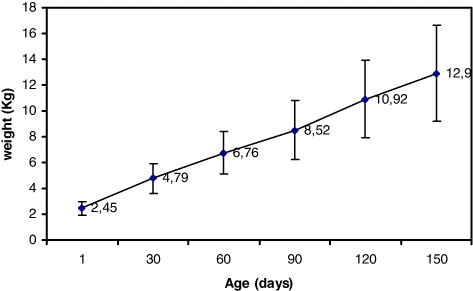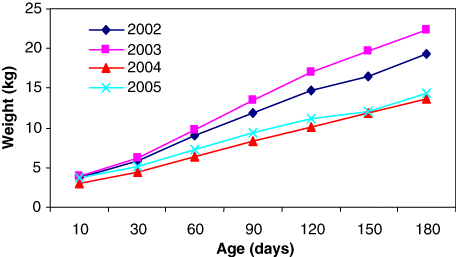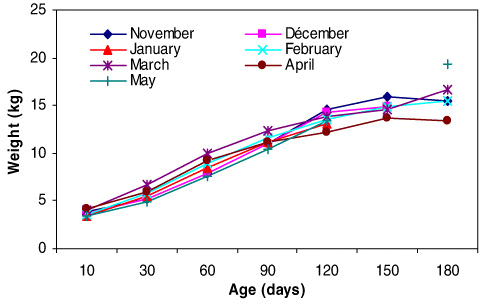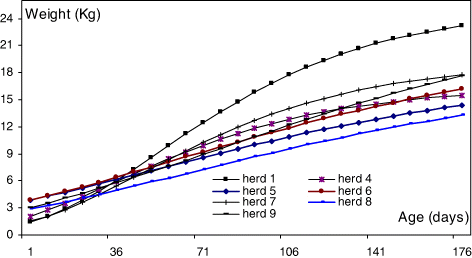Abstract
Data issued from a weighing protocol of 722 kids during four years was analysed to establish the impacts of non-genetic factors upon kids’ weights at some standard ages. A Gompertz model was applied to estimate kids’ weights at some standard ages 1, 10, 30, 60, 90, 120, 150 and 180 days. A GLM procedure and a means comparison test (SNK, α = 0.05) were applied to identify the statistical effects of some factors and their homogenous classes at several ages. The determination coefficient R2 remains lower than 87% of all studied traits due to the observed data structure. All traits seem to be affected (P<0.001 or 0.05) by the factors related to the restrictions and the irregularities of the technical and natural environment of pastoral husbandry. The non-genetic factors impact increases with kids’ age and requirements. Growth traits varied depending to the natural and technical factors which illustrates the local population genetic response towards environmental resources in arid zone. The year and zone factors play an important role upon the kid's weight and it evolution till 6 months age due to the large inter-annual variation of rainfall. Also the technical level of the herder seems affecting highly the kids’ performances. Therefore, arid environment affects both quantitatively and qualitatively individual kid's growing behaviour and have to be considered for local goat rational genetic improvement modelling and planning.
1. Introduction
Despite of the deep social evolution of the Tunisian arid zone, the pastoral breeding mode remains the main activity enable to valorise the rangelands resources by ambulant small ruminant herds under harsh irregular conditions (Ouled Belgacem Citation2006; Ouni et al. Citation2006; Koc and Ceylan Citation2009). In fact, the zone allows raising more than 60% of the national caprine herd estimated about 1,500,000 goats (DGPA Citation2009; FAO Citation2010). Kids’ meat represents about 75% of the local meat production (Das et al. Citation2007; Najari et al. Citation2007a, Citation2007b). The main product of the traditional breeding mode of the indigenous goat is the meat of kids slaughtered is summer season (Argüello et al. Citation2004; Thavaprakaash and Velayudham Citation2010; Argüello Citation2011).
Consequently, the kid's growth during this early age represents an important phenotype to yield the increasing income to the ambulant herds (Ouni et al. Citation2006; Dharmaveer et al. Citation2007). Under pastoral harsh conditions with restricted and irregular resources, the goat productivity is high influenced by non-genetic factors because of the extensive grazing management (Mahjoub et al. Citation2005; Maiti and Ahlawat Citation2010; Najari et al. Citation2006).
Under arid conditions, rather than the classic effects of non-genetic factors upon growth kids, a specific qualitative action of harsh condition was verified (Najari et al. Citation2002; Argüello et al. Citation2004; Sundararaman et al. Citation2007). Indeed, severe conditions, do not allow the animals to express their real genetic potential (El-Hassan et al. Citation2009).
As quantitative phenotypes, kids’ weights change by all factors affecting the growth rather than the individual genetic potential differences (Schinckel and De Lange Citation1996; Alexandre et al. Citation1997; Bocquier et al. Citation1998; Oltenacu Citation1999; Bughio et al. Citation2002).
The study aims to estimate the natural and technical non-genetic effects on indigenous kids’ weights under pastoral conditions in the Tunisian arid region. Also, we purpose understanding kids’ growing behaviour of indigenous kids towards arid environment factors by the analysis of a large data-set collected within ambulant herds. Rather than the local population characterisation, the results may improve the husbandry policy to optimise the herd production and land conservation considering the serious desertification risks in the studied area.
All the experimental goats were raised in Arid Areas Institute of Médenine (IRA), in the South-East of Tunisia (North Africa) and is submitted to an arid continental Mediterranean climate, with irregular and sporadic rains, average annual rainfall of 200 mm, average annual temperature of 20.2°C (Ferchichi Citation1996; Arbi Citation2004). The experiment was started since 2002 and continued till 2005.
The population of local goats varied in coat colour, body weights, body size and morphostructural characteristic. The Tunisian goat is characterised by its small body size with an average height of 76 cm for the male and 60 cm for the female (Najari et al. Citation2007b; Ouni et al. Citation2007). Native goat is hairy and basically black, with the fertility rate of about 87% and prolificacy rate of 110–130% (Najari et al. Citation2006). The season of kidding begins at October and continues till February, with a concentration during November and December.
About 4900 weights records were collected on 722 local kids born in 2001–2005 by a periodical weighing programme from December (kidding period) to August. The records included ear mark of dam and kid, coat colour, birth type, birthday, sex, body weights and weighing dates of each kid and the age of dam at kidbearing. Body weights were recorded every two weeks with a precision as 0.05 kg using the routine method, and then adjusted at the age of 1, 30, 60, 90, 120 and 150 days by the Gompertz model (Najari Citation2005). The year of birth (2002–2005), kidding month (January, February, March and December), birth type (single and twins), sex (male and female), coat colour of kid and age of dam (2–10 years) were defined as the non-genetic factors.
The effects of the non-genetic factors on the body weights at different ages were obtained by an ANOVA analysis using the following model:
Means comparison test (SNK=5%) was performed to test the classes homogeneity.
2. Results and discussions
The test of significance for body weights at the age of 1, 30, 60, 90, 120 and 150 days according to different kidding year and month, the natural zone and the herd of Tunisian local kids are presented in . The body weights at the age of 1 day to 150 days of Tunisian local kids significantly varied from the different kidding year, herd and natural zone (). The birth month has significant effect (P<0.01) on all the body weights except the weight at the age of 30 days.
Table 1. The test of significance for body weights at the age of 0, 30, 60, 90, 120 and 150 days according to different kidding year and month, the sex, birth type and coat colour of kids and the age of dam of Tunisian local kids.
The non-genetic factors were found to be statistically significant for body weights at the age of 1, 15 and 60 days. While for body weights at the age of 30 and 45 days, only the year and birth type effects were found to be statistically significant (Portolano et al. Citation2002; Koc and Ceylan Citation2009). The mean body weight at the age of 150 days is almost five times with respect the body weight at birth. According to Ouni et al. (Citation2006) and Iheukwumere et al. (Citation2008), the animals of this breed take approximately the stature of an adult with this age. However, our findings demonstrated that only 4/5 of the adult body mass is reached at 5 months age. Morand-Fehr (Citation1981) and Bughio et al. (Citation2001) announced that birth weight of a kid primarily depends on the body conformation and size of their parents. In fact, the body weight of the dam and the birth weight of their kids have positive correlation coefficient irrespective of the litter sizes (Morand-Fehr Citation1981).
At the beginning of the summer, we have pointed out that the evolution of the growth is slow and the estimate of the adult body weight was 16.2 kg, which is lower than the estimate (24 kg) by Najari (Citation2005). It possibly resulted from the adaptive strategy to the different management and growth conditions (Le Gal Planchenault Citation1993; Sundararaman et al. Citation2007).
The most important period of growth seems to be the first five month of life, when the growth rate allowed by the kids produce the main part of the adult (Najari Citation2005; Dharmaveer et al. Citation2007; Najari et al. Citation2007a).
Moreover, the considerable diversity found in all the reference ages tested in the population as it is demonstrated by the high values of the standard deviations.
2.1. The year of birth effects on kids’ growth
The averages of body weights at the age of 1, 30, 60, 90, 120 and 150 days of Tunisian local kids from the kidding year of 2002 to 2005 and kidding month of 1, 2, 3 and 12 are given in .
Table 2. The means of body weights at the age of 0, 30, 60, 90, 120 and 150 days of local kids from the kidding year of 2002 to 2005.
The kidding year presents a highly significant effect (P<0.01) on the kids body weights from birth to 150 days (). These factors have lower significant influence on the birth weight, probably because the maternal effects tampons in part the negative influence in bad years, such as the dam have to survive under harsh conditions in this period. Ndlovu and Simela (Citation1996) and Bughio et al. (Citation2001, Citation2002) obtained similar results for goats from Zimbabwe. Najari et al. (Citation2007a) also mentioned a significant influence (P<0.05) of the kidding year due to the annual resources variation, which affect seriously the productivity of the pasture.
The rainfall scarcity and irregularity, as the heats and cold oscillations, are the main natural factors affect the growth of the animals, especially for the young kids. The year characterizes the arid environment, because it conditioned the food scarcity which is supposed the main reason for this source of variability (Najari et al. Citation2007a; Ouni et al. Citation2007). The relevancy of the year effect on the growth performances under difficult conditions has been highlighted by other reports (Alexandre et al. Citation1997; Zhang et al. Citation2006; Mousa Citation2011). Ndlovu and Simela (Citation1996) reported that the kids born in the hot dry season were heavier (P<0.05) at the age of 60 and 90 days than those born in the hot wet season.
2.2. The birth season effects on kids’ growth
The effect of birth season on the body weight (P<0.05) varied at the different ages (). The kids born in the hot wet season are lighter than those born in the other two seasons.
As it is given in , the month of birth has significant effect on the body weights from birth to 150 days, except for 30 days, which agrees with the results reported by Zhang et al. (Citation2007). Similar season effects have been found by several other authors (Nadarajah et al. Citation1995; Abebe Citation1996; Mousa Citation2011).
Table 3. The means of body weights at the age of 1, 30, 60, 90, 120 and 150 days of local kids according to the kidding month of 1, 2, 3 and 12.
Effect of the month is due to the different food conditions generated in each season for the climatic conditions, especially in the arid areas (Ferchichi Citation1996). Pastoral resources are consequently very variables in one month to another, affecting thus directly by the kids growth and indirectly by the means of the milk production (Sajlu et al. Citation1999; Dharmaveer et al. Citation2007). Zhang et al. (Citation2007) reported that the variations of weight for Boer goat in different years and seasons might be explained partly by differences in management and sample size, partly by differences of rainfall which in turn influenced grass production and food availability.
2.3. The ecological zone effects on kids' growth
The natural zone affects kid's growth through the resources and the herd management not homogenous in studied ecological zone such as steppic, costal and mountainous zone (Ouled Belgacem Citation2006; Najari et al. Citation2007b; El-Hassan et al. Citation2009). In the coastal zone, the livestock plays a secondary role in the family incomes and the pastoral lands are regressing in favour to oil culture (Iheukwumere et al. Citation2008; Tavsanoglu Citation2008). Whereas, in the second zone, the livestock remains he principal activity and herds graze extensively the vast communal lands and pasture without sensible mobility restrictions. While in mountainous zone, goatherds valorise accidental and vacant lands (Yadav and Yadav Citation2007).
The zones corresponding growth curves are presented in . The most ‘regular’, S-shaped growth curves are observed to the steppe and the mountain. The heaviest asymptotic weight was observed for the mountain kids having 22.72 kg, while, the lowest kid's weight are those raised in the costal zone (El-Hassan et al. Citation2009). Similar effects of the natural and technical resources upon the kids growth were advanced in a numerous studies.
2.4. The herd effect upon kid's growth
Rather than the classic effect of herd upon animal performances, this non-genetic technical factor has a particular importance in the pastoral breeding system of the arid region. The management response towards the resources scarcity and irregularity is determining upon the herd production (Kanwal et al. Citation2004). One of the pastoral management principles is the herd's mobility, practiced since the nomadic period. Transhumance allows to valorise distinct pasture according to their vegetal state and thus, to stamp the arid resources restrictions and irregularities. Due to the herd mobility hardness and costs, only little number of herds remains able to practice duly the transhumance to satisfy the animal's requirements.
Also, in this extensive grazing mode, the herder ability remains the principal factor conditioning the herd cash flow (Najari et al. Citation2006). In fact, the herd management is based on the traditional knowledge to prevent natural stresses and to ensure the best offered conditions to satisfy animal requirements (Najari et al. Citation2006; Iheukwumere et al. Citation2008).
Rather than technical management differences, the genetic level varies between herds (Ouni et al. Citation2007). Morphologically, some herd specificities were easily revealed on the animals’ morphology due to long intra-herd consanguine mating. Traditionally, each family selects its own herd on some visible characters to avoid animals’ mixture on pastures or during the watering days when many herds are gathered (Najari et al. Citation2006; El-Hassan et al. Citation2009). These simplified selection schemes can affect productive performances such as kids’ growth.
During the first month age, herds’ differences are not enough clear (). Among the nine herds studied (), kids of the herd number 1 show the best growing performances since 2 months of age and till the age of 6 months. The asymptotic weight corresponding to the herd 1 reaches 25.28 kg.
Differences between herds' performances increase with age to become remarkable after 40 days age (). At the age of 180 days, this difference reaches 17.4 kg.
Note that the interaction herd×region showed a significant effect upon the majority of analysed traits; the herd management vary with respect to the natural resources of each region (Odeyinka et al. Citation2007; Mousa Citation2011). In fact, herd management and the breeding mode differ according to herd importance and the forage availability.
3. Conclusions
The non-genetic effects such as kidding year and month are very important to the early growth of Tunisian local kids. The kidding year illustrates a significant effect (P<0.01) on body weights at the age of 1 day to 150 days. The birth month has significant effect (P<0.01) on all the body weights except the weight at the age of 30 days. Thus, the herd productivity seems affected by the range lands resources and the climatic conditions both restrictive and irregular in arid zones. The non-genetic factors affect directly the animal physiology and indirectly through the pastoral forage varying.
The Tunisian goats breeds are a local genetic resource perfectly adapted to the production of goat meat in semi-arid conditions. The phenotypical variability found in this paper promises a good capacity of genetic response to selection when the breeding programme could be implemented.
References
- Abebe G. 1996. Studies on performance potential of Somali goats and their crosses with Anglo-Nubian: A contribution to breed documentation and evaluation [Dissertation]. Berlin: Humboldt Universität Berlin. Institut für Nutztierwissen schaften. Verlag Dr. Köster. ISBN 3-89574-204-X. 258 p.
- Alexandre G, Aumont G, Despois P, Mainaud JC, Coppry O, Xandé A. 1997. Productive performances of Guadeloupean Creole goats during the suckling period. Small Ruminant Research 34:157–162.
- Arbi M. 2004. Effet d'un supplementation alimentaire sur le profil hormonal de la chèvre locale dans le sud tunisien [Food summly effects on hormonal profile of the local goats in the southern Tunisia]. Mémoire de fin de 3èmè cycle de [Master of Science Memory], FST Carthage University, p. 88.
- Argüello A. 2011. Trends in goat research, a review. Journal of Applied Animal Research 39(4):429–434. 10.1080/09712119.2011.637362
- Argüello A, Castro N, Capote J. 2004. Growth of milk replacer kids fed under three different managements. Journal of Applied Animal Research 25(1):37–40. 10.1080/09712119.2004.9706470
- Bocquier F, Leboeuf B, Rouel J, Chilliard Y. 1998. Nutrition effects and breeding mode upon young goat performances. Inra Productions Animales 11:311–320.
- Bughio S, Baloch MH, Oad FC, Moryani AA, Mirani AH, Brohi MA. 2001. Productive performance of Kamori goat flock under semi-intensive management. Journal of Applied Science 1:347–348. 10.3923/jas.2001.347.348
- Bughio S, Moriani AA, Mirani AH, Oad FC, Bughio BA. 2002. Reproductive performance of Kamori goat flock under semi-intensive management system. Journal of Applied Science 2:747–749. 10.3923/jas.2002.747.749
- Das AK, Sharma RB, Singh NP. 2007. Quality and storage stability of low acid goat meat pickle. American Journal of Food Technology 2:550–554. 10.3923/ajft.2007.550.554
- Dharmaveer S, Rajkumar V, Mukesh KP. 2007. Quality and shelf life of smoked chevon sausages packed under vacuum and stored at 4±1 °C. American Journal of Food Technology 2:238–247. 10.3923/ajft.2007.238.247
- DGPA. 2009. Governmental statistics of Tunisian government. Agriculture Minister. 45 pp.
- El-Hassan K, Al-Abid H, Abu Nikhaila AMA. 2009. A study on some non-genetic factors and their impact on some reproductive traits of Sudanese Nubian goats. International Journal of Dairy Science4:152–158.10.3923/ijds.2009.152.158
- FAO. 2010. Food and agriculture organisation statistics. Rome: FAO.
- Ferchichi A. 1996. Proposal for a new index of climatic subdivision of the stages Mediterranean arid and Saharan. In: International seminar “scientific and perspective Assets for a durable development of the arid regions”. Review of the Arid Areas. Special number. pp. 13–25.
- Iheukwumere FC, Abu AH, Okoli IC. 2008. Effect of FSH+LH (Pergonal®) treatments on hormonal profile and superovulatory response of West African dwarf does. Asian Journal of Scientific Research 1:281–287. 10.3923/ajsr.2008.281.287
- Kanwal R, Ahmed T, Mirza B. 2004. Comparative analysis of quality of milk collected from buffalo, cow, goat and sheep of Rawalpindi/Islamabad region in Pakistan. Asian Journal of Plant Science 3:300–305. 10.3923/ajps.2004.300.305
- Koc B, Ceylan M. 2009. General status and long term trend analysis of sheep and goat husbandry in the Eastern Anatolian region of Turkey. Asian Journal of Agriculture Research 3:18–27. 10.3923/ajar.2009.18.27
- Le Gal Planchenault O. 1993. Use of the caprine races in the hot zones: constraints and interests. Toulouse: UCARDEC CTA. p. 26.
- Mahjoub O, Lu CD, Hameed MS, Richie A, Al-Halhali AS, Annamalai K. 2005. Performance of Omani goats fed diets containing various metabolisable energy densities. Small Ruminant Research 58:175–180. 10.1016/j.smallrumres.2004.09.008
- Maiti AK, Ahlawat SS. 2010. Effect of natural tenderizers on physico-chemical properties of chicken gizzard and goat heart. American Journal of Food Technology 6:80–86.
- Morand-Fehr P. 1981. Growth. In: Gall C., editor Goat production. London: Academic Press. p. 253–283.
- Mousa MRM. 2011. Effect of partial replacement of dietary concentrate feed mixture by fodder Beet roots on productive performance of Ewes and doe goats under the conditions of North Sinai. Asian Journal of Animal Science 5:228–242. 10.3923/ajas.2011.228.242
- Nadarajah K, Burnside EB, Kennedy D. 1995. Estimation of phenotypic and genetic parameters for growth of goats enrolled in the Ontario Goat Herd Improvement Program. Ontario: Centre for Genetic Improvement of Livestock. Annual report.
- Najari S. 2005. Zootechnical and genetic characterization of a caprine population. Case of the local caprine population of the Tunisian arid areas [Thesis of doctorate of State]. 214 p.
- Najari S, Ben Hamouda M, Khaldi G. 2002. Expression of the kid's genotypes in arid regions conditions. In: Elsen JM, Ducroq V, editors. 7th word congress on genetics applied to livestock production, 2002. Arid Land Institute: Tunisia. p. 401–404. Montpellier, France.
- Najari S, Gaddour A, Abdennebi M, Ben Hamouda M, Khaldi G. 2006. Morphological characterization of the local caprine population of the Tunisian arid areas. Review of the Arid Areas 17:23–41.
- Najari S, Gaddour A, Ben Hamouda M, Djemali M, Khaldi G. 2007a. Growth model adjustment of local goat population under pastoral conditions in Tunisian arid zone. Journal of Agronomy 6(1):61–67. 10.3923/ja.2007.61.67
- Najari S, Gaddour A, Ouni M, Abdennebi M, Ben Hamouda M. 2007b. Indigenous kids weight variation with respect to non genetic factors under pastoral mode in Tunisian Arid Region. Journal of Animal and Veterinary Advances 6(3):441–450.
- Ndlovu LR, Simela L. 1996. Effect of season of birth and sex of kid on the production of live weaned single born kids in smallholder East African goat flocks in North East Zimbabwe. Small Ruminant Research 22:1–6. 10.1016/0921-4488(95)00844-6
- Odeyinka SM, Torimiro DO, Oyedele JO, Asaolu VO. 2007. Farmer's awareness and knowledge of Moringa oleifera in Southwestern Nigeria: a perceptional analysis. Asian Journal of Plant Science 6:320–325. 10.3923/ajps.2007.320.325
- Oltenacu EAB. 1999. Using math to see how well your goat is growing. New York state 4H meat goat project fact sheet 16. Ithaca, NY: Cornell University.
- Ouni M, Gaddour A, Najari S, Abdennabi M, Khorchani T. 2007. Influences of the non genetic factors on the Ponderal growth of the kids of the local caprine population in the Tunisian arid areas “18 èmes Biological Days; 2nd Day of Biotechnology Tunisian Association of Biological Sciences Association Maghrébine de Biotechnologie” March 25–28, 2007.
- Ouni M, Gaddour A, Najari S, Abdennabi M, Ben Hammouda M, Khorchani T. 2006. Morphometric characterization of the genetic resources of the small ruminants (caprine) of the Tunisian Arid Areas. In: IRA, editors. Proceeding of the seminar; 2006 sep 18–21. Arid Land Institute: Medenine, Tunisia.
- Ouled Belgacem A. 2006. Ecological statute, biological performance and aptitude of the reinstatement of stipa lagascae R and SCH in the degraded ecosystems of the Tunisian arid mediums [ Thesis doctorate]. Sfax University Edition: Tunisia. 147 p.
- Portolano B, Todaro M, Finocchiaro R, van Kaam JHBCM. 2002. Estimation of the genetic and phenotypic variance of several growth traits of the Sicilian Girgentana goat. Small Ruminant Research 45:247–253. 10.1016/S0921-4488(02)00161-X
- Sajlu T, Hart SP, Goetsch AL. 1999. Effects of level of feed intake on body weight, body components, and mohair growth in Angora goats during realimentation. Small Ruminant Research 33:251–259.
- Schinckel AP, De Lange CFM. 1996. Characterization of growth parameters needed as inputs for pig growth models. Journal of Animal Science 74:2021–2036.
- Sundararaman MN, Kalatharan J, Edwin MJ. 2007. Attempts to achieve semen collections from incapacitated Boer Bucks by electro-ejaculation. Asian Journal of Animal and Veterinary Advances 2:244–246. 10.3923/ajava.2007.244.246
- Tavsanoglu C. 2008. The effect of aspect on post-fire recovery of a mixed Lebanon cedar-Anatolian black pine forest: After the first 5 years. Asian Journal of Plant Science 7:696–699. 10.3923/ajps.2008.696.699
- Thavaprakaash N, Velayudham K. 2010. Effect of crop geometry, intercropping systems and INM practices on cob yield and nutrient uptake of baby corn. Asian Journal of Agricultural Research 1:10–16.
- Yadav A, Yadav BR. 2007. Genetic diversity among six breeds of Indian goat using RAPD markers. Biotechnology 6:57–60. 10.3923/biotech.2007.57.60
- Zhang WJ, Xu ZR, Pan XL, Yan XH, Wang YB. 2007. Variance components and genetic parameters for weight and size at birth in the Boer goat. Livestock Science 111(1–2):1–9.
- Zhang CY, Shen Z, Zhou ZQ, Yang LG. 2006. Studies on the growth and developmental rules of young Boer goat. Journal of Huazhong Agricultural University 12:640–644.




